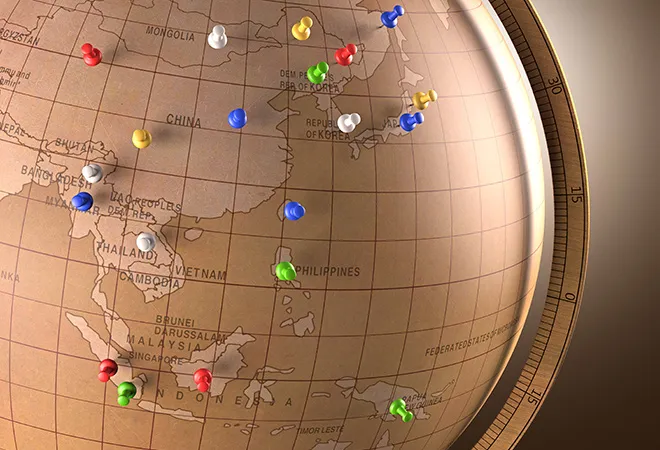-
CENTRES
Progammes & Centres
Location
As we usher in 2022, we unpack the events and trends of 2021 that are likely to dominate East Asian politics in the coming years

With the Asian Development Bank estimating that COVID-19 pushed close to 80 million people into extreme poverty, the pandemic’s devastating economic consequences on Asia in 2021 are well known. Advanced East Asian economies of Japan, South Korea and Taiwan were not spared the consequences. In Japan, the perceived mishandling of the crisis and slow rates of vaccination toppled Prime Minister Suga. While Taiwan and South Korea pulled off relatively more successful efforts to combat the pandemic, the ongoing gridlock in the global supply chains is likely to hamper recovery. With images of fleets of shipping vessels moored off the coasts of major global ports dominating headlines and a strong economic recovery from the ravages of COVID-19 the need of the hour, expect supply chains and economic security to remain major talking points in 2022.
In East Asia, the looming specter of China is holding policymakers’ feet to the fire on this issue. Japan’s new Prime Minister, Fumio Kishida, has already created a berth in his Cabinet for a Minister of Economic Security. Taiwan’s semiconductor giants have unveiled big ticket plans to shift production to Japan and even further afield to the United States (US). After its economy almost ground to a halt following the shortage of urea imports from China, South Korea announced the creation of a new centre within its foreign affairs apparatus to scope out the country’s supply chain vulnerabilities. North Korea, on the other hand, reinforced its status as the “Hermit Kingdom” when it sealed its borders with the outside world to guard against infections.
After its economy almost ground to a halt following the shortage of urea imports from China, South Korea announced the creation of a new centre within its foreign affairs apparatus to scope out the country’s supply chain vulnerabilities.
Another key development to watch will be the unfolding drama over China’s accession to the Comprehensive and Progressive Agreement for Trans-Pacific Partnership (CPTPP). Over the course of this year, the United Kingdom (UK), Taiwan, South Korea and China have all announced their intention to accede to the trade accord. With many speculating that the CPTPP represents a crucial forum for the development of international economic rules, China’s gameplan is clear. Further, with the US still reluctant to rejoin the deal it helped negotiate, entering the CPTPP will allow Beijing to effectively cut its greatest rival out of Asia’s economic architecture. However, with Japan and Australia likely to bar the door to China’s entry, a bruising political clash seems to be brewing as we enter 2022. As economic growth takes priority in the aftermath of COVID-19, the US is still missing in action. While the Biden Administration has made noises calling for an “Indo-Pacific Economic Framework”, it has revealed little about its plans. The dangers of a security-heavy strategy in a region that is searching for economic growth are apparent. 2022 may see a clearer articulation of America’s economic goals in the region.
Despite the pandemic shocks clamouring for their attention, the region’s leaders managed to find time to rehash and refresh political tensions in the region. China’s repeated transgressions into Taiwan’s Air Defence Identification Zone dominated news headlines in 2021. Beijing is increasingly anxious about a Taiwan that is more comfortable forging a unique and distinct cultural and political identity for itself. As the political power of pro-China forces in Taiwan wanes, Beijing has opted for a show of force to cow the 23 million denizens of the island nation into reaffirming their support for a One China policy. Beijing and Moscow poured oil over troubled waters later in 2021 as they conducted a joint naval operation sailing through Japan’s Tsugaru Straits. In a year that saw both the Quad Summit and the AUKUS nuclear submarine pact, Moscow and Beijing’s actions reflect a desire to signal the power of their deepening partnership. 2021 also represented a missed opportunity for Japan-South Korea ties. Since their relationship entered a downward spiral over a spat regarding Japan’s colonial rule in Korea in 2018, no amount of cajoling by friends or challenges posed by foes has managed to bring these key players together. Even at the G7 Meetings in June, both sides took aim at each other publicly. Should the Korean people elect the conservative Yoon Seok Yeol to the Presidency in March 2022, this may change. Yoon and key leaders in his Korea People Power Party have expressed an interest in working through tensions with counterparts in Tokyo. Given its importance to any US efforts to counter China in East Asia, the Seoul-Tokyo relationship will be one to watch in 2022. In 2021, Pyongyang kept tensions high on the Korean peninsula by refusing to meet with Washington’s envoy. After President Biden’s decision to eschew former President Trump’s more personalised approach in favour of more traditional diplomacy, both sides have been locked in a standoff.
Beijing is increasingly anxious about a Taiwan that is more comfortable forging a unique and distinct cultural and political identity for itself.
The timbre of the times in Asia reflects a worrying trend towards a new arms race. While China’s acquisition of cutting-edge hypersonic missiles took pole position in the minds of global policymakers, the rest of Northeast Asia was not far behind. True to form, the North Koreans welcomed the incoming Biden Administration by testing new cruise missiles, showcasing their new and improved nuclear-capable missile arsenal and other military trinkets over the course of 2021. Seoul, casting a cold eye on the actions of its quarrelsome Northern neighbour, launched a new submarine launched ballistic missile. Further, Washington and Seoul have also lifted long-standing restrictions on the range of South Korea’s missiles. These developments have opened up the possibility of a South Korean military that possesses a full suite of offensive capabilities. 2022 will see the country’s embattled progressives square off in a Presidential election against the more hardline conservatives. Should a conservative politician occupy the Blue House, Seoul might well pull closer to US political and diplomatic efforts to counter China. Given this, a more overtly capable South Korean military seems here to stay.
Not to be outdone, Japan has placed military and security matters at the heart of government policymaking in years past. In the closing days of 2021, Tokyo announced a five-year defence outlay of US $264 billion starting in 2023. This hike will be put towards acquiring F-35 jets, bolstering domestic defence manufacturing and developing Japan’s cybersecurity and space-based capabilities. In 2022, one would be well served to keep an eye on Japan’s domestic politics. The recently concluded elections there have deposited a powerful coalition in power that has the interest and political firepower to back a revision of Japan’s pacifist constitution. While reforming the constitution will doubtless be an uphill battle, it is worth watching all the same.
Seoul, casting a cold eye on the actions of its quarrelsome Northern neighbour, launched a new submarine launched ballistic missile.
Finally, 2021 saw old wine return in new battleships to the troubled waters of East Asia. The UK’s push for a “Global Britain” saw it send a carrier strike group led by the HMS Queen Elizabeth to call on Japan. The strike group, accompanied by US forces, exercised with Japanese armed forces before returning home. This, taken together with the UK’s application to join CPTPP and its backing for the AUKUS nuclear submarine pact, is as clear a sign as any that the UK’s long sabbatical from East Asia’s politics may be coming to a close. 2021 also saw the EU release its strategy for the Indo-Pacific. From boosting funding for infrastructure projects in the region, which will require the support of experienced players like Japan, to boosting their security and trade presence in the region, the EU’s strategy promises much. With France remaining the only EU power with a significant naval presence in the region, it remains to be seen whether the Quad and other regional players can rely on the grouping to do some of the heavy lifting on defence. Nevertheless, the EU’s funding for development, climate transitions and strategic infrastructure (most notably through the recently announced multi billion dollar Global Gateway Project) will help with the regional economic balance.
2021 was but a confirmation of a trend many feared: Competition seems here to stay. Although the world hopes for peace in 2022, nobody seems to be holding their breath.
The views expressed above belong to the author(s). ORF research and analyses now available on Telegram! Click here to access our curated content — blogs, longforms and interviews.

Shashank Mattoo was a Junior Fellow with the ORFs Strategic Studies Program. His research focuses on North-East Asian security and foreign policy. ...
Read More +